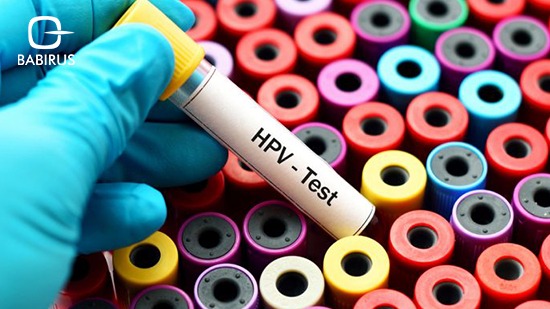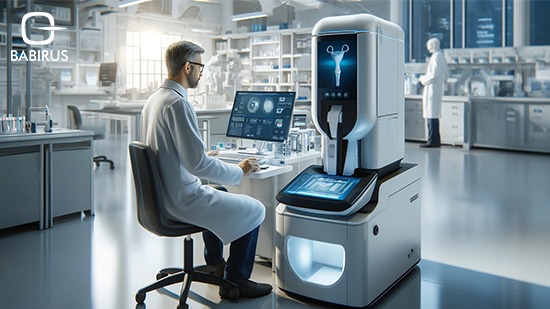Top Machines for Molecular Diagnostics for Papillomavirus

Have you ever wondered about the invisible threat lurking behind cervical cancer’s shadow? Human Papillomavirus (HPV), a common yet silent virus, is considered one of the primary causes behind most cervical cancer cases.
The HPV virus silently infiltrates the body, often without any symptoms, making early detection with the best machine for molecular diagnostics of human papillomavirus crucial for prevention.
Today we will dive into the basics of human papillomavirus, list the top molecular diagnostics of human papillomavirus machines, and answer the most common questions on choosing an HPV testing machine that is right for your lab.
Understanding Molecular Diagnostics for HPV:
To help you really understand the importance of molecular diagnostics of human papillomavirus, we need to share with you first some essential information to know what HPV is.
Human Papillomavirus term, or HPV, is used to refer to a group of viruses that can cause various health issues, ranging from common warts to more serious conditions like cervical cancer. It is primarily transmitted through sexual contact, but it can also be spread through skin-to-skin contact. This virus infects the skin and mucous membranes, leading to abnormal cell growth and the development of different types of lesions.
Moreover, one of the biggest concerns about HPV is its link to cervical cancer. Because the existence of HPV can lead to the development of cervical abnormalities and, over time, progress into cancer. However, it is important to note that while HPV infection is a risk factor for cervical cancer, not all HPV infections result in cancer.
Thus, regular screenings and early detection of molecular diagnostics of human papillomavirus are vital for preventing the progression of HPV-related cervical abnormalities to cancerous stages.
Molecular diagnostics of human papillomavirus involve detecting the DNA or RNA of the virus in clinical samples, typically using methods like Polymerase Chain Reaction (PCR) or Real-Time PCR. These techniques offer high sensitivity and specificity that is crucial for identifying both high-risk and low-risk HPV types leading to different and more efficient clinical outcomes.

Top 5 Molecular Diagnostics Machines for HPV:
Choosing a machine for molecular diagnostics of human papillomavirus testing requires evaluating how many targets the machine detects, the time to result, and the ease of use. To help with this, here are some top HPV testing machines that offer reliable HPV DNA detection, each equipped to handle the specific demands of HPV testing in clinical settings.
1. Panagene PANA RealTyper™ Screening Kit for HPV:
The PANA RealTyper™ HPV Kit by Panagene is popular for its efficiency and accuracy in screening and genotyping HPV. It detects 14 high-risk and 2 low-risk HPV types, vital for evaluating cervical cancer risk.
Utilizing Real-Time PCR technology, this kit delivers results quickly, making it an excellent choice for both screening and diagnostic applications.
2. Roche Cobas® 4800 HPV Test:
The Roche Cobas® 4800 system offers high-throughput molecular diagnostics for HPV, capable of providing individual results for HPV 16 and HPV 18, along with a simultaneous, pooled result for other high-risk genotypes, all in one run, with one sample from the patient.
The system’s automation and integration capabilities make it ideal for laboratories with high testing volumes, delivering the first result in approximately 3.5 hours.
3. Hologic Panther® System:
Hologic’s Panther® system is a fully automated platform that performs nucleic acid testing for HPV. It provides quantitative detection of 16, 18, and 45 HPV types and delivers the first 5 results within 3.5 hours.
Its main advantage is the integration of sample processing, amplification, and detection in one platform, enhancing laboratory efficiency.
4. Abbott RealTime High-Risk HPV Test:
Abbott’s RealTime High-Risk HPV Test offers comprehensive detection, identifying 14 high-risk HPV types. This test provides specific genotyping information for HPV types 16 and 18, which are commonly associated with cervical cancer, while simultaneously detecting 12 other high-risk types.
5. BD Onclarity™ HPV Assay:
The BD Onclarity™ HPV Assay runs on the BD Viper™ LT system and can detect and provide individual results for 6 HPV genotypes with the highest risk for disease (16,18,45,31, 51, 52) and strategically grouped results for lower-risk HPV genotypes (33,58,35,39,68,56,59,66).
Results from this system are available within a few hours, depending on the sample batch size.
Considerations for Choosing an HPV Testing Machine:
If you are looking to select a testing machine for molecular diagnostics of human papillomavirus, you need to consider several factors such as:
· Detection Capability: The ability to differentiate between high-risk and low-risk HPV types.
· Speed of Results: How quickly the system can deliver results, which is crucial in situations that require fast outcomes.
· Throughput: The number of samples the machine can process at once, which is important for high-volume labs.
· Ease of Use: Automated functions and user-friendly interfaces can reduce manual errors and boost lab efficiency.
5 FAQs About Molecular Diagnostics of Human Papillomavirus:
Below we will answer some most asked questions about choosing an HPV testing machine and about molecular diagnostics for HPV.
1. How Does Molecular Diagnostics Work for HPV Testing?
Molecular diagnostics for HPV typically involve HPV DNA detection techniques, like PCR, to strengthen the virus’s genetic material, making it easier to detect even in low quantities.
The detecting process typically includes extraction of the genetic material followed by amplification to increase the virus’s genetic material, and then detection of the virus, which will then give the healthcare provider a diagnosis based on whether the targeted HPV is present in the patient sample or not.
2. What Are the Specific HPV Types Detected by Leading Molecular Diagnostics Machines?
Most HPV DNA detection machines detect a range of HPV types, typically focusing on the 14 high-risk types known to be associated with cervical cancer which include HPV types 16, 18, 31, 33, 35, 39, 45, 51, 52, 56, 58, 59, 66 and 68.
3. How Do Multiplex Assays Improve HPV Testing Efficiency?
Multiplex assays in molecular diagnostics of human papillomavirus play a big role in HPV testing efficiency. Moreover, these assays enable the simultaneous HPV DNA detection of multiple HPV types in a single sample.
Based on the multiplex features of HPV testing machines, laboratories can:
· Streamline their workflow.
· Reduce the number of reagents needed.
· Make the overall testing time shorter.
This efficiency factor is important when choosing an HPV testing machine as it helps with managing high sample volumes, and ensuring that patients receive timely and accurate results.
Moreover, the ability to detect several HPV types with one sample and one test circle enhances the comprehensiveness of the screening process, which leads to more effective clinical decision-making in the context of cervical cancer prevention.
4. What Is Point-Of-Care Testing for HPV And How Can It Improve Accessibility?
Point-of-care (POC) testing for HPV is a key advancement in molecular diagnostics of human papillomavirus. As this testing method allows for immediate HPV DNA detection at or near the location where patient care is provided, eliminating the need to send samples to a distant laboratory.
By using top POC testing machines designed for HPV detection, healthcare providers can amazingly reduce the needed time for testing and diagnosing. Which is highly important to boost preventive healthcare services and efficient screening availability in remote and underserved areas.
5. How Are Advancements in HPV Testing Technology Contributing to Cervical Cancer Prevention Efforts?
The improvements in the technology for molecular diagnostics of human papillomavirus have greatly improved the effectiveness of cervical cancer prevention. Especially with the greater offered sensitivity and accuracy in HPV DNA detection that effectively identifies infections early.
All these advancements in the features of HPV testing machines allow for better identification of high-risk HPV types, which are very important for real evaluation of the cervical cancer risk rate.
To wrap up,
Choosing the right machine for molecular diagnostics of human papillomavirus is crucial in our global battle against cervical cancer.
Thus, you need to contact us to help you understand the features and capabilities of top machines available in the UAE market, and then make an informed and efficient decision for preparing or developing your healthcare facility.

